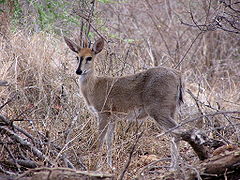Grym szary
Grym szary[5] (Sylvicapra grimmia) – gatunek ssaka z podrodziny antylop (Antilopinae) w obrębie rodziny wołowatych (Bovidae), jedyny przedstawiciel rodzaju grym (Sylvicapra) Ogilby, 1837, zaliczany do niewielkich antylop nazywanych dujkerami. Wyróżniono kilkanaście podgatunków gryma.
| Sylvicapra grimmia | |||
| (Linnaeus, 1758) | |||

| |||
| Systematyka | |||
| Domena | |||
|---|---|---|---|
| Królestwo | |||
| Gromada | |||
| Podgromada | |||
| Infragromada | |||
| Rząd | |||
| Podrząd | |||
| Infrarząd | |||
| Rodzina | |||
| Podrodzina | |||
| Plemię | |||
| Rodzaj | |||
| Gatunek |
grym szary | ||
| Synonimy | |||
| |||
| Kategoria zagrożenia (CKGZ)[4] | |||
 | |||
Występowanie i biotop
edytujAfryka Subsaharyjska[4]. Zasiedla tereny trawiaste, zarośla i rzadkie lasy. Spotykany na terenach uprawnych.
Charakterystyka
edytujDługość ciała samic 90–115 cm, samców 70–105 cm, długość ogona 10–20 cm, wysokość w kłębie 39–68 cm; długość rogów 7,5–18 cm; masa ciała samic 10,3–26,3 kg, samców 9,7–22,4 kg[6], ubarwienie brązowe, z ciemną pręgą na głowie. Samcom wyrastają niewielkie, proste rogi. Grymy prowadzą nocny tryb życia, żyją samotnie lub w parach. Ciąża u tego gatunku trwa cztery miesiące, na świat przychodzi zwykle jedno młode.
Przypisy
edytuj- ↑ W. Ogilby. On the generic characters of Ruminants. „Proceedings of the Zoological Society of London”. 4, s. 138, 1836. (ang.).
- ↑ Ch.L. Laurillard: L’Antilope a bourse. W: A. d’Orbigny: Dictionnaire universel d’histoire naturelle: résumant et complétant tous les faits présentés par les encyclopédies, les anciens dictionnaires scientifiques, les Oeuvres complètes de Buffon, et les meilleurs traités spéciaux sur les diverses branches des sciences nautrelles; donnant la description des etres et des divers phénomènes de la nature, l’étymologie et la définition des noms scientifiques, et les principales applications des corps organiques et inorganiques à l’agriculture, à la médecine, aux arts industriels, etc.. Cz. 1. Paris: Chez les editeurs MM. Renard, Martinet et cie, rue et Hotel Mignon, 2 (quartier de l’École-de-Médecine); et chez Langlois et Leclercq, rue de la Harpe, 81; Victor Masson, Place de l’Ecole-de-Médecin, 1841, s. 623. (fr.).
- ↑ J.E. Gray. Descriptions of some new genera and fifty unrecorded species of Mammalia. „The Annals and Magazine of Natural History”. 10, s. 266, 1842. (ang.).
- ↑ a b Sylvicapra grimmia, [w:] The IUCN Red List of Threatened Species (ang.).
- ↑ Włodzimierz Cichocki, Agnieszka Ważna, Jan Cichocki, Ewa Rajska, Artur Jasiński, Wiesław Bogdanowicz: Polskie nazewnictwo ssaków świata. Warszawa: Muzeum i Instytut Zoologii Polskiej Akademii Nauk, 2015, s. 297. ISBN 978-83-88147-15-9.
- ↑ C. Groves, D. Leslie, B. Huffman, R. Valdez, K. Habibi, P. Weinberg, J. Burton, P. Jarman & W. Robichaud: Family Bovidae (Hollow-horned Ruminants). W: D.E. Wilson & R.A. Mittermeier (redaktorzy): Handbook of the Mammals of the World. Cz. 2: Hoofed Mammals. Barcelona: Lynx Edicions, 2011, s. 751–752. ISBN 978-84-96553-77-4. (ang.).
Bibliografia
edytuj- Halina Komosińska, Elżbieta Podsiadło: Ssaki kopytne. Warszawa: Wydawnictwo Naukowe PWN, 2002. ISBN 83-01-13806-8.
- Wilson Don E. & Reeder DeeAnn M. (red.) Sylvicapra grimmia. w: Mammal Species of the World. A Taxonomic and Geographic Reference (Wyd. 3.) [on-line]. Johns Hopkins University Press, 2005. (ang.) [dostęp 16 stycznia 2009]